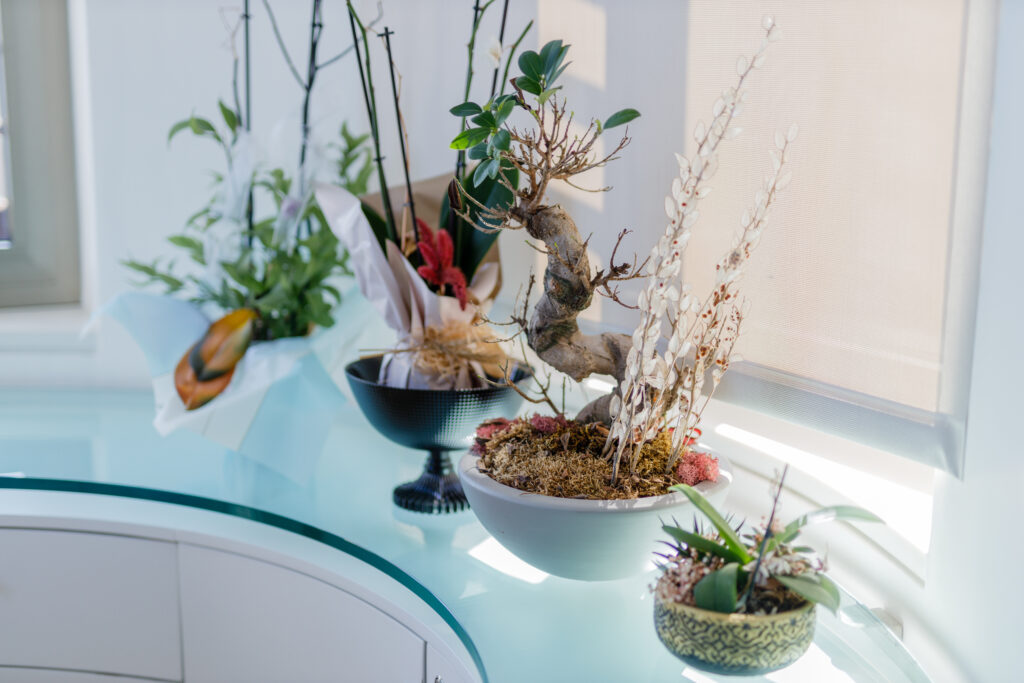Proper terrarium lighting is the cornerstone of a thriving miniature ecosystem. While terrariums create beautiful displays in glass containers, ensuring your plants receive the right amount and quality of light can be the difference between a flourishing display and a struggling arrangement. Let’s explore how to master both natural and artificial light sources for optimal plant care.
Understanding Light Requirements for Terrarium Plants
Different plants have varying light needs, making it essential to group species with similar requirements in the same glass container. Consider these general categories:
Low Light Plants
- Ferns (Maidenhair, Boston, Bird’s Nest)
- Mosses
- Certain Peperomias
- Fittonias (Nerve Plants)
Medium Light Plants
- Pothos varieties
- Philodendron
- Cryptanthus
- Pilea species
High Light Plants
- Succulents
- Cacti
- Air plants (Tillandsia)
- Crotons

Harnessing Natural Light for Terrariums
Natural sunlight provides the full spectrum of light that plants need, but using it effectively requires understanding its characteristics:
Window Placement Strategies
North-Facing Windows
- Provide gentle, indirect indoor light
- Ideal for low-light loving plants
- May require supplemental lighting during winter months
- Rarely cause heat buildup in glass containers
East-Facing Windows
- Offer morning sun, which is gentle yet effective
- Perfect for medium-light plants
- Provides balanced light without excessive heat
- Creates beautiful morning illumination through glass containers
South-Facing Windows
- Deliver the strongest indoor light intensity
- Excellent for high-light plants like succulents
- Require monitoring to prevent overheating
- May need sheer curtains to diffuse intense midday light
West-Facing Windows
- Provide afternoon sun, which tends to be hotter
- Suitable for succulents and cacti
- Require careful monitoring for heat buildup
- May create striking evening illumination effects
Seasonal Light Adjustments
Remember that window light changes significantly between seasons. A perfect spot in winter may become too intense in summer. Monitor your terrarium regularly and be prepared to relocate it as seasons change.
Incorporating Artificial Grow Lights
When natural light is insufficient or inconsistent, grow lights provide a reliable solution:
Types of Grow Lights for Terrariums
LED Grow Lights
- Energy-efficient and long-lasting
- Emit minimal heat, reducing risk of overheating
- Available in full-spectrum options that mimic sunlight
- Can be found in stylish designs that complement home décor
Fluorescent Grow Lights
- Affordable and widely available
- Provide good spectrum for most terrarium plants
- Emit low heat, safe for most glass containers
- T5 HO (High Output) bulbs offer excellent light intensity
Smart Grow Lights
- Feature timers and intensity controls
- Can be programmed to match natural light cycles
- Often controlled via smartphone apps
- Some models adjust color temperature throughout the day
Creating the Perfect Lighting Setup
Distance Considerations
Position grow lights 6-12 inches above your terrarium for optimal light penetration without heat damage. Adjust this distance based on your specific plants and light intensity.
Duration Guidelines
Most terrarium plants thrive with 12-14 hours of light daily. Use a timer to ensure consistency and prevent both over and under-lighting issues.
Signs of Lighting Problems
Too Much Light
- Yellowing or bleached leaves
- Brown, dry leaf edges
- Wilting despite adequate moisture
- Condensation rapidly evaporating in closed systems
Too Little Light
- Elongated, stretched growth (etiolation)
- Smaller new leaves
- Fading variegation
- Slow or stalled growth
- Leaning toward light sources
Balancing Natural and Artificial Light
For many terrarium enthusiasts, combining both lighting sources creates the ideal environment:
Hybrid Lighting Strategy
Use natural window light as your primary source, supplemented with grow lights during cloudy days or winter months when natural light diminishes. This approach provides plants with natural light cycles while ensuring they never lack sufficient intensity.
Rotating Your Terrarium
Even under ideal terrarium lighting conditions, plants will grow toward the light source. Rotate your glass container quarter-turn weekly to promote even growth and maintain your intended design aesthetic.
Light Filtering Techniques
Sometimes, moderating light intensity is necessary:
- Use sheer curtains to diffuse harsh direct sunlight
- Apply window films that reduce UV while maintaining brightness
- Position your terrarium behind taller houseplants for natural filtering
- Place decorative screens between windows and terrariums during peak intensity




